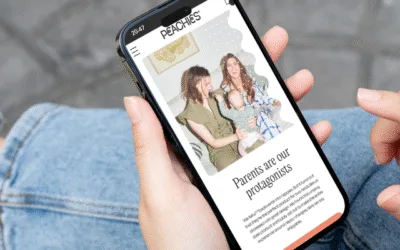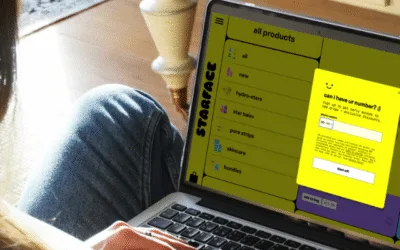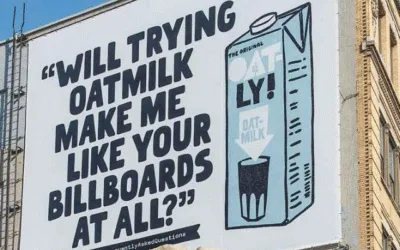Peachies beat Pampers by selling sleep, not nappies. Learn their Ladder of Why messaging trick to make your copy resonate.
Your brand only has a voice if you have something worth saying.
There's loads of competition for a distinct brand voice and AI only makes it easier to have a bold style. The answer? Find your hill to die on.
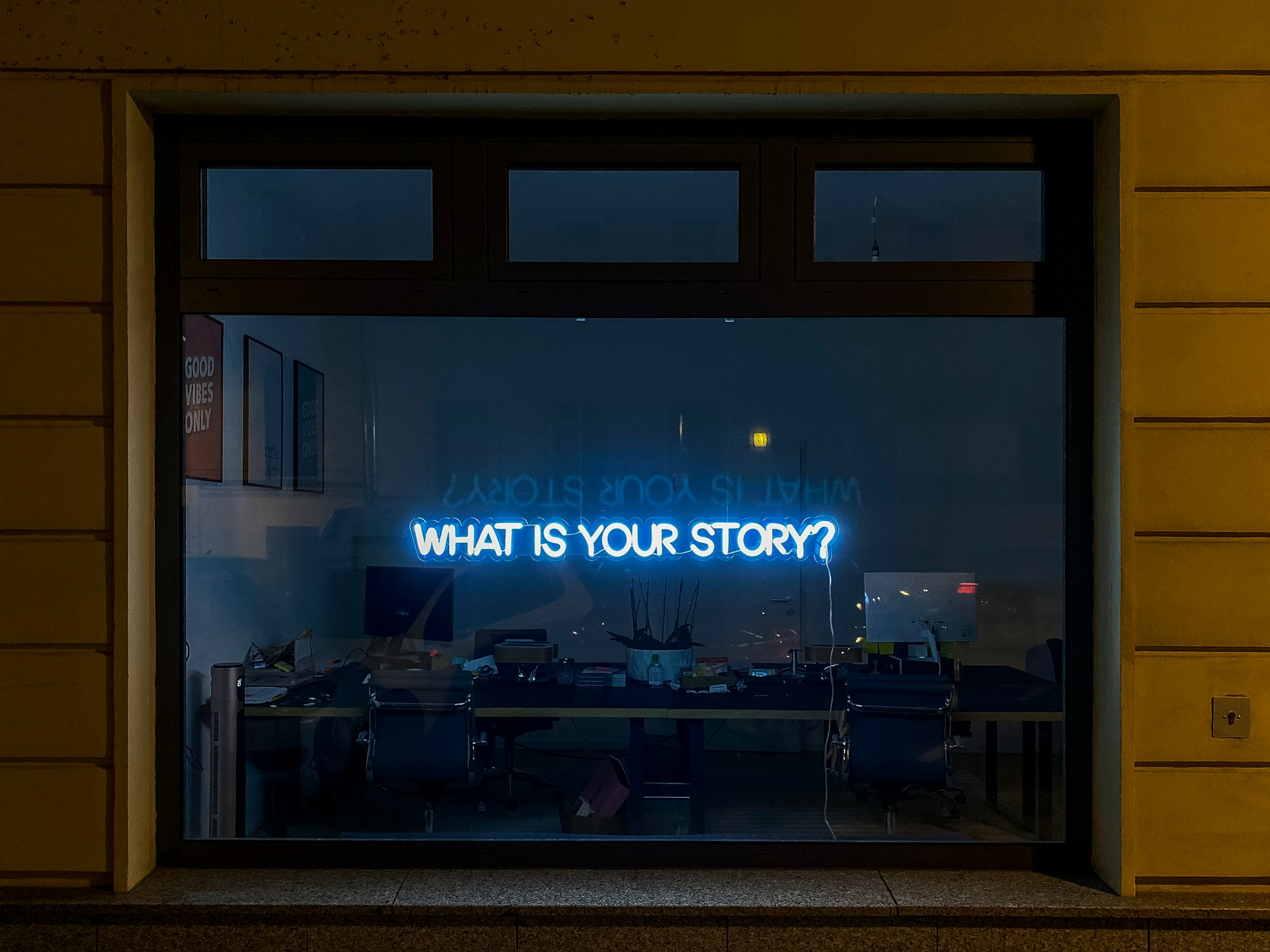
Get pro copy tips, branding tricks and e-comm insights directly to your inbox every Tuesday.
Last week, one of you legends reached out with a question:
“How can we have a unique brand voice when anybody can get ChatGPT to copy the way we write in an instant?”
It’s a great question.
Unlike your logo or brand identity, you can’t copyright a brand voice. You can have the most distinct voice in your industry and there’s nada you can do to stop a brand copying how you say stuff.
Check this out 👇
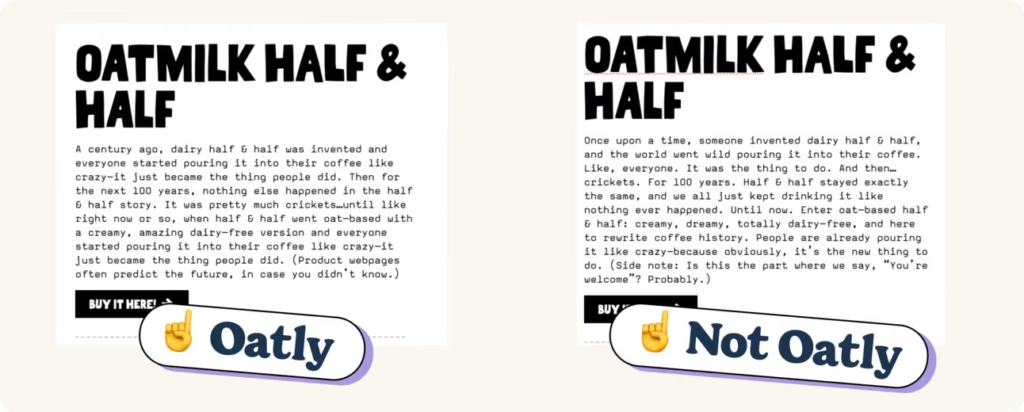
But it’s not all doom and gloom.

Even though it’s easy to copy Oatly’s brand voice, when you see their copy you think “That’s Oatly” and when you see brands with a similar voice, you think “They’re trying to sound like Oatly”.
The difference? Oatly has got something to say. And that’s what separates really good brand voices from window dressing brand voices.
🎬 Brand voice tips from the big screen 👇
There’s a scene in A Star is Born where Bradley Cooper’s character and his brother (played by the one and only, Mustache of the Century-winner Sam Elliot) are having it out.
Turns out, Bradley Cooper’s character copied his brother’s singing voice and got famous off of the back of it.
It goes like this:
Bobby : If I was no good, why did you steal my fucking voice? Huh?
Jack : Cause you had nothing to fucking say.

And while I’m pretty sure B-Coop wasn’t writing about copywriting, there’s not a huge amount of difference between a singer connecting with a crowd and your brand connecting with your customers.
In other words, you can’t have a brand voice — that is, fully-formed and customer-grabbing brand voice — if you have nothing of substance to say.
Good brand voices have style. Great brand voices have substance.
Whenever we work with clients who are still hammering out their brand voice, the same brands come up over and over again as inspiration.
Patagonia, Innocent, Nike, Oatly, Monzo…
And there’s a good reason they crop up every time — their voices aren’t bells and whistles. They’re more than “we start sentences with verbs” or a well-placed emoji.
They’re more than just 3 words that describe how they write.
Look at any of the brands that really nail their brand voice and you’ll see that their voices only work so well because they have something to say.
- Nike: Belief: “If you have a body, you’re an athlete.” 👉 Voice: Empowering, bold, inspirational.
- Oatly: Belief: “The dairy industry is broken. Oat milk is the future.” 👉 Voice: Playful, provocative, rebellious.
- Monzo: Belief: “Banking should be transparent, user-friendly, and humane.” 👉 Voice: Straightforward, empathetic, and conversational.
All the stylistic elements of their voice are a direct result of their distinct point of view. They’re all born of that something that only they can say.
Of course, that something differs from brand to brand.
Some have things to say about the state of the world, others have something to say about how we can live better lives and others just have something to say about the industry they’re in.
But at their core is the same thing: a central, outspoken belief in something that guides everything they do. And that’s the central idea that their voice is built around.
And customers respond to that.
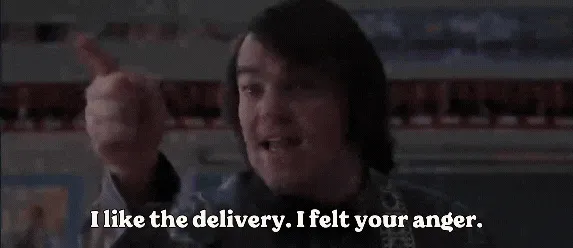
Customers when you don’t 👉 “You’re tacky and I hate you!”
Since we started writing brand voice documents about 10 years ago, tone of voice has gone from something that was an afterthought to something everybody is doing 👇
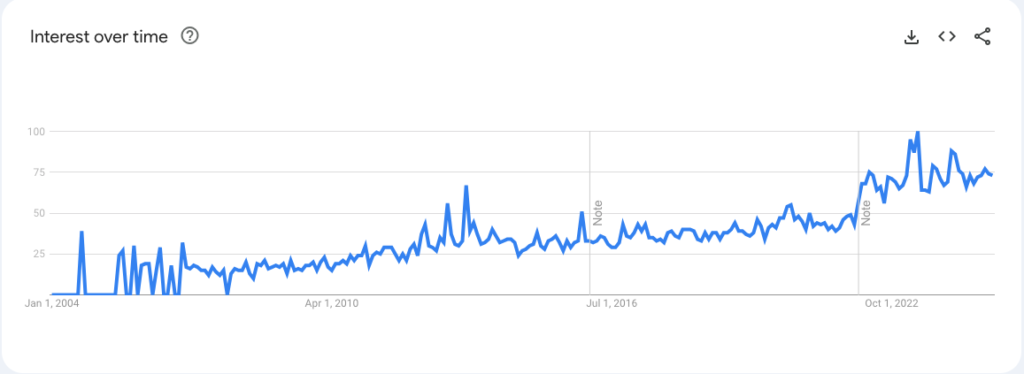
And as AI becomes scarily good at copying all of the linguistic quirks, stylistic choices and on-brand phrases that — to an untrained eye, at least — constitute a “voice”, your brand’s voice needs to evolve beyond just the words you choose.
It needs to be the living embodiment of what you stand for as a brand.
A cautionary tale: use other brands as inspiration, don’t copy them outright.
Finding your brand voice takes time and work so it makes sense to look around for inspiration.
And there aren’t many better places to start than Innocent.
Innocent Smoothies are brand voice OGs. They’re responsible for brand voice going mainstream (in the UK, at least) and for the launching of a thousand wackaging competitors.
But, on a technical level, there isn’t much to separate this Innocent packaging 👇
Witty, playful, light-hearted fun.
..with this from Frijj (a UK milkshake brand) 👇
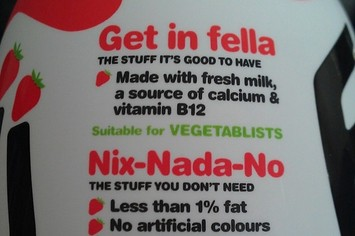
(☝️ By the way, I still have nightmares about this Frijj bottle. “Vegetablists?” “Get in fella?” 🤢 )
They’re both using surreal humour, personifying the brand and very conversational language to make a connection with the customer.
However, the thing that separates Innocent’s copy from Frijj’s is that, for Innocent, those words are a direct extension of their belief that making healthier choices should be fun and easy.
Because of that, it feels genuine. It feels substantive.
For Frijj, their words are (I would bet a substantial amount of money) a direct extension of somebody saying “Innocent have funny copy, we need that too.”
As a result, “Get in fella” doesn’t feel like an authentic expression or extension of the brand’s beliefs.
“Suitable for vegetablists” doesn’t come from a central belief or giving a shit about anything beyond selling more milkshake.
(If anything, that lack of respect for the term vegetarian probably reveals more about their brand values than they’d care to admit.)
And customers can spot the difference.
They might not spend weeks trying to write articles about it like us, but they’ll know it doesn’t feel right. It doesn’t sit right.
TLDR: to get beyond a voice that’s little more than imitation — a performance of linguistic quirks and gimmicks — and into the Holy Land of Brand Voices, you have to have a damn opinion.
Here’s how you do that 👇
Find the thing you really give a shit about and build your voice around that
Your opinion doesn’t have to be earth-shattering.
Your brand just has to believe in something, whether that’s delivering better customer service in an industry with a shitty reputation (like Monzo), making it simpler to make healthy choices (Innocent) or bringing inspiration and innovation to every athlete in the world (Nike).
It’s not just good for voice, it’s good for brand loyalty too 👇
👉 A study highlighted by Consumer Goods Technology found that 82% of shoppers desire consumer brands’ values to align with their own, and a significant 75% have parted ways with a brand over a conflict in values.
👉 A global study reported by Forbes reveals that consumers are four to six times more likely to purchase from, trust, champion, and defend companies with a strong purpose.
And that something has to bleed into everything you write.
That something has to be the starting point of everything you do.
You can’t say you believe in making things simpler and then fill your website with 40-word long sentences full of jargon.
You can’t say you want to make ice-cream fun but have Brewdog-esque, aggressively divisive copy that insults your customers. (With a few details changed, this is a conversation I had with a brand once. 🤦)
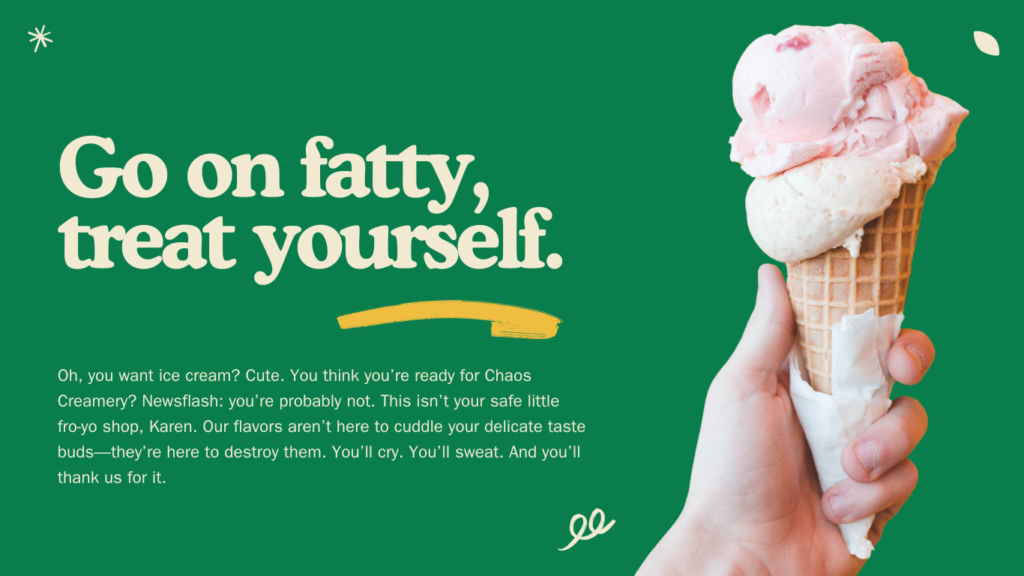
But you also can’t just whack some chatty copy and emojis on your website or packaging and call it a “brand voice”.
Instead, take a look at your copy and ask yourself:
👉 What does our brand believe in?
👉 What does our brand stand for?
👉 What do we give a shit about?
Is your voice helping your brand send the right signals? Is it helping to communicate The Big Idea that your brand gives the biggest of shits about?
If not, it should be. It should be at the heart of everything you write. It doesn’t have to be explicit — in fact, it probably shouldn’t be — but it should be there, beneath the surface, like a groovy bassline holding the song together.
And the great thing?
Having this give-a-fuck-ness nailed down makes everything you write easier.
With this clear sense of what you stand for nailed, everything becomes clear.
Suddenly, everything from what music you use on an Instagram reel to what social media trends you jump on to what gifs you use, all click into place.
💡 Brand that’s all about empowering women? Using misogynistic rap in a reel won’t jive with your voice.
💡 Brand that’s all about saving the planet or doing good? Maybe don’t use a Taylor Swift gif, no matter how viral it’s going.
The tricky thing about brand voice is that it’s so nebulous. Your customers aren’t going to sit down and consciously analyse which gifs you use, what words you use, etc…
They’re just going to pick up on the vibe.
You’re using what you say and how you say it to create that vibe or a core idea of who you are as a brand, and one slip-up can undo all of your hard work in seconds.
In branding, this is called congruence. Does every part of your brand feel connected and of one brand? Does your voice match your font choice match your graphic design match your social media presence match your logo, etc… does it all feel cohesive?
But it goes further too, does this brand feel congruent with your target audience? Does it match up with how they see themselves? Do the values you’re displaying match their values?
🧠 Research shows that when your brand’s personality and values line up with your customers’ personality and values, it dramatically increases brand loyalty, purchase intent and engagement.
How to define and build your belief-driven voice
Here’s the part where we roll up our sleeves.
Alas, finding your Big Belief at the heart of your brand voice isn’t a quick “answer three questions and call it a day” thing.
We’ve spent weeks working with clients on this before, really drilling down into what they believe in and what they stand for.
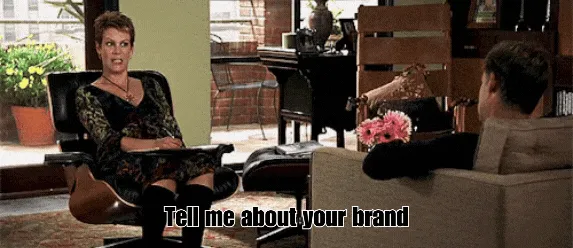
Step #1: find your big belief (or your why)
We know, we know… More marketing people talking about Simon Sinek. How gauche.
At this point, you’ve probably seen Simon Sinek’s How Great Leaders Inspire Action TED talk enough times that you can quote it in your sleep. (If not, check it out!)
Truth be told, we’re not 100% sold on Sinek’s idea as the Most Important Thing. We think that’s a little too simplistic. A little too easy. And it has a little too much survivorship bias built into it.
But it is a fantastic starting point for this exercise. Humans love back stories and origin stories and understanding each other’s intentions, so getting clear on WHY you exist is a really important stage of nailing down the foundations of your voice.
Ask yourself: why did we start the business?
And go deep on this. Don’t just say “there was a gap in the market and the chance to make mad bank”.
(And even if that is true, there was a reason you chose this industry not the thousands of others. What drew you to this? What made you think you could do it better than anyone else?)
Likewise, don’t go too big. “To change the world” or “To give customers a better experience” are too broad and generic to have any real meaning.
Get specific. Get ambitious.
Start with these prompts:
- If we were a superhero, what would our origin story be? (Sometimes, detaching yourself from the brand and seeing it as a character helps you get some much-needed distance from it.)
- What’s broken in your industry or the world? What pisses you off?
- What change do you want to see? What lights you up?
- What is your brand’s nemesis? What things are the antithesis of what your brand stands for?
- Go further still, what brands are the antithesis of everything your brand stands for? Why? How are you different?
- What’s your stake in the ground? What hill would your brand die on?
If you really want to get into it, here’s the Million Dollar Question we ask clients to cut through the surface level answers: what part of your brand and values would you never change, even if it meant losing money?
📖Want to dig into this more? We did a post on the idea of brand nemeses on Instagram last year. Check it out. (And give us a follow!)
Step #2: turn those beliefs and ideas into a voice
This is the bit where it all gets a bit woo-woo, but bear with us…
Imagine your brand is a person that shares your values.
How would they talk? What kind of words would they use? Would they be bold and in your face? Would they be mellow and chill AF? Would they be a bit playful and chatty?
What gifs would they use? What music would they put on their reels? Do they swear? Do they use the yellow tone emojis?
Which emojis would they never use?
Now start to narrow that down into a sense of your voice.
Remember: repeatedly ask yourself whether the way you’re writing is sending the same message as your brand’s Big Message
(For example, if your message is bold and ambitious, does your copy match up with this? Likewise, if you’re selling CBD gummies to help people chill but your voice is big and bold, it’s going to create a mish-mash.)
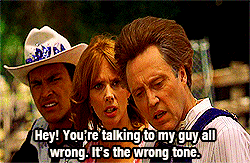
Then, start to define and describe that voice with adjectives.
Ultimately, the style element of brand voice is about where your brand falls on 4 axes:
- Funny vs. serious
- Casual vs. formal
- Irreverent vs respectful
- Enthusiastic vs. matter-of-fact
So start whittling down where your voice falls between those points as your starting point, then dig deeper.
If you’re funny, how are you funny? Sarcastic? Surreal? Childish?
If you’re casual, how are you casual? Like a colleague over coffee or like your mates over a drink?
And so on…
Document this with This Not That phrases:
The trouble with brand voices is that even when they’re well defined, they’re open to interpretation by different writers.
If we say our brand is sarcastic, then my idea of sarcasm and your idea of sarcasm are probably slightly different. Maybe mine is meaner and yours is more duh. Same with things like bold or divisive or chill or witty… they’re all ambiguous.
That’s why it helps to come up with This Not That statements for each of your brand voice adjectives.
For example 👇️
👉 We’re sarcastic but not mean-spirited.
👉 We’re outspoken but not offensive.
👉 We’re witty like Steven Fry, not Ricky Gervais.
👉 We’re divisive but we’re not edgy for edgy’s sake.
Etc…
By doing this, you end up with a much clearer bullseye for your brand voice. (And make it much harder to copy.)
Step #3: Document it, share it with your team and use it internally
Now you’ve nailed down your brand’s Big Belief and figured out how that belief shapes your voice, it’s time for the not-so-glamorous part: using it consistently.
In the old days — and by that, we mean 5ish years ago, in The Before Times — we used to wax lyrically about how even the best brand voice won’t stick if it keeps flipping between sassy social butterfly and buttoned-up boardroom exec…
That was when it was about connecting with your customers and standing out.
Now, it’s more important than that.
When your voice and your values are one and the same — as they should be — changing your voice undermines trust in your values and makes you look like you’re green-washing or woke-washing or whatever-washing…
In other words, your Big Beliefs look performative and hollow. And modern consumers hate brands that aren’t authentic.
Here’s how to avoid that 👇️
Create a brand voice guide (and actually use it)
If your brand voice is your personality, your style guide is your recipe book.
Make sure you’ve defined the key elements of your voice, tone, and style for everyone who writes for your brand.
Think of it as a manual for being “you” in words and include:
- A brief overview of your mission and beliefs: Get everybody involved in the why of your voice so they know how important it is to get right.
- A summary of your brand voice, including those This, Not That statements: Recap those handy guidelines that clarify how your voice should (and shouldn’t) sound.
- Some examples of your brand voice in action: Pick some of your most on-brand copy and show it off. Explain why it’s on-brand too.
- Pro tip: we love to include Goldilocks Tests when we develop brand voices. Essentially, we dial a voice down, up and get it just right and explain why each version is or isn’t right for the brand. Most people learn brand voice intuitively, so lean into that.
- A list of words to avoid: Just as important as what you do say is what you don’t say. (E.g., if you’re a chill, friendly brand, you probably don’t use corporate buzzwords like “synergy” or “paradigm shift.” 🤮)
- Show how your tone shifts in different contexts: Your voice might shift slightly depending on the platform or audience. Outline how it should sound in an email vs. on TikTok, or in a press release vs. a meme.
Train your team on how to use it (and use it internally)
Whether it’s your in-house writers, social media manager, or a freelancer on a tight deadline, everyone who represents your brand should know your voice inside-out.
Host workshops, share examples, and encourage questions in a Slack channel, because — trust us — no one gets it perfect on the first try.
And most importantly, use it in your internal communications.
Remember: nowadays, everybody writes for your brand.
Your marketing team or copywriter might write the really important stuff, but what about the service emails to customers?
The terms and conditions? The tiny bits of copy? Product descriptions? Shipping emails? The live chat on your site? The communications with suppliers?
The best way to make sure the whole team talk the same way (so the brand always sounds the same) is to make sure that they’re picking up the voice through osmosis. Every interaction they have with the brand internally should reflect and affirm the values and voice you want them to use externally.
So, if there’s an important document like a contract or a memo, use it show them that it’s OK to still have some personality, even in the stickier situations.
Don’t make them turn to the brand voice guidelines at every opportunity, lead by example and help them intuitively know how to write for your brand in every situation.
Because using your brand voice internally isn’t just about making sure that the people who work for (and with) you live and breathe the brand. And it’s not just about joining up your voice at every single customer touchpoint, either.
It’s also about giving your team the confidence and freedom to speak on the brand’s behalf without second-guessing themselves.
(Because second guessing almost always equals stilted, safe and boring language that undermines your voice.)
In fact, I’ve heard that innocent do a week-long training session for all new members of staff to get them up to speed with their brand voice, whether they’re in marketing or not, because they know how important it is that everybody knows it inside out.
Steal this brand voice guide: Monzo
If you want to borrow some ideas from the best brand voice guide we’ve ever seen, look no further than Monzo.
It’s written in their voice. It explains why they write how they write. It empowers everybody at Monzo to use it. And it’s super clear and actionable, with real-life examples.
And best of all? It all comes back to their central belief as a brand, that banking should be simple and human. Top stuff. No notes.
Dive into more free tips and tricks 👇
How Starface use orthography to build a killer brand voice their customers love
The words you write matter. But so do your full stops, emojis and lowercase letters. Learn how to turn punctuation into a powerful part of your brand voice.
Why Oatly’s brand voice is so damn good (and how yours can be, too)
We dig into the three layers of brand voice (10,000ft, 1,000ft, ground level), show how Oatly nails each one and how you can do it for your own brand.
The weekly newsletter that takes your brand’s copy from “meh” to “hell f*cking yeah!”
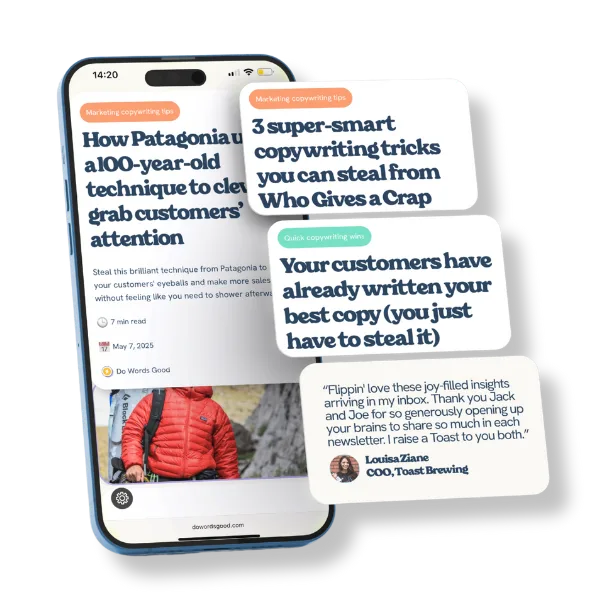
Read every week by legends at brands like these











